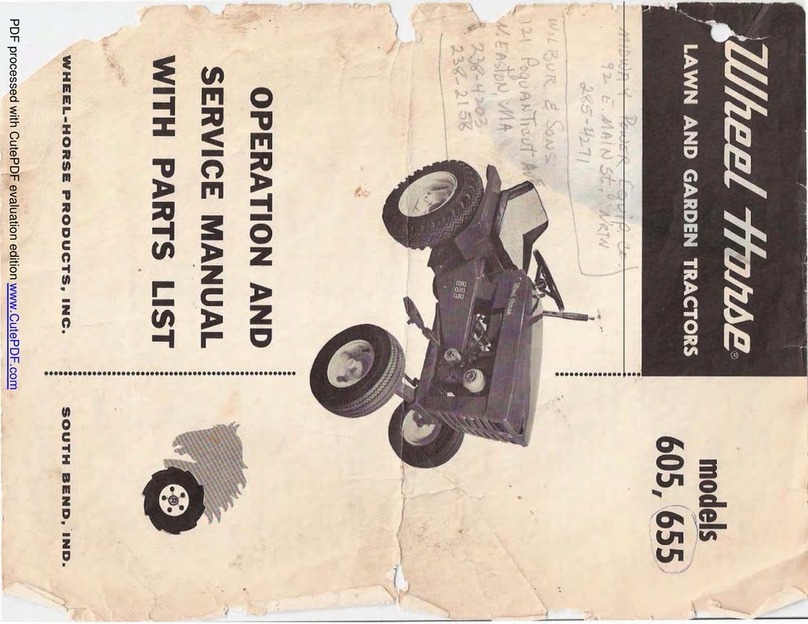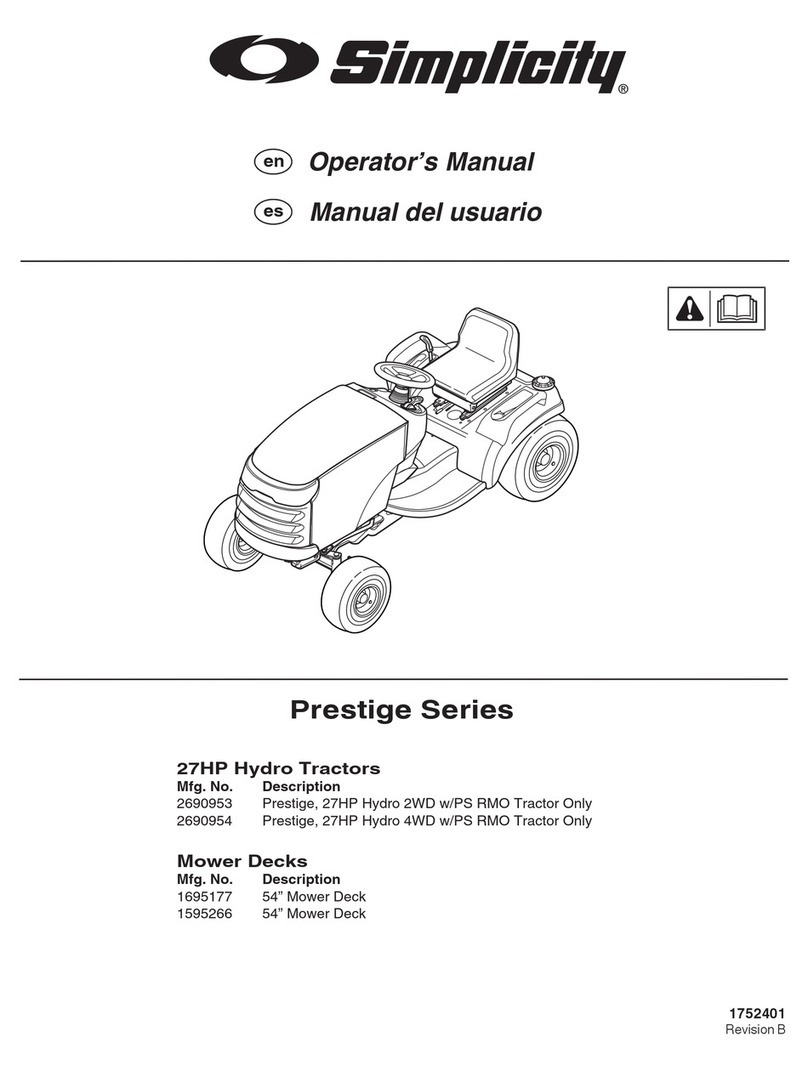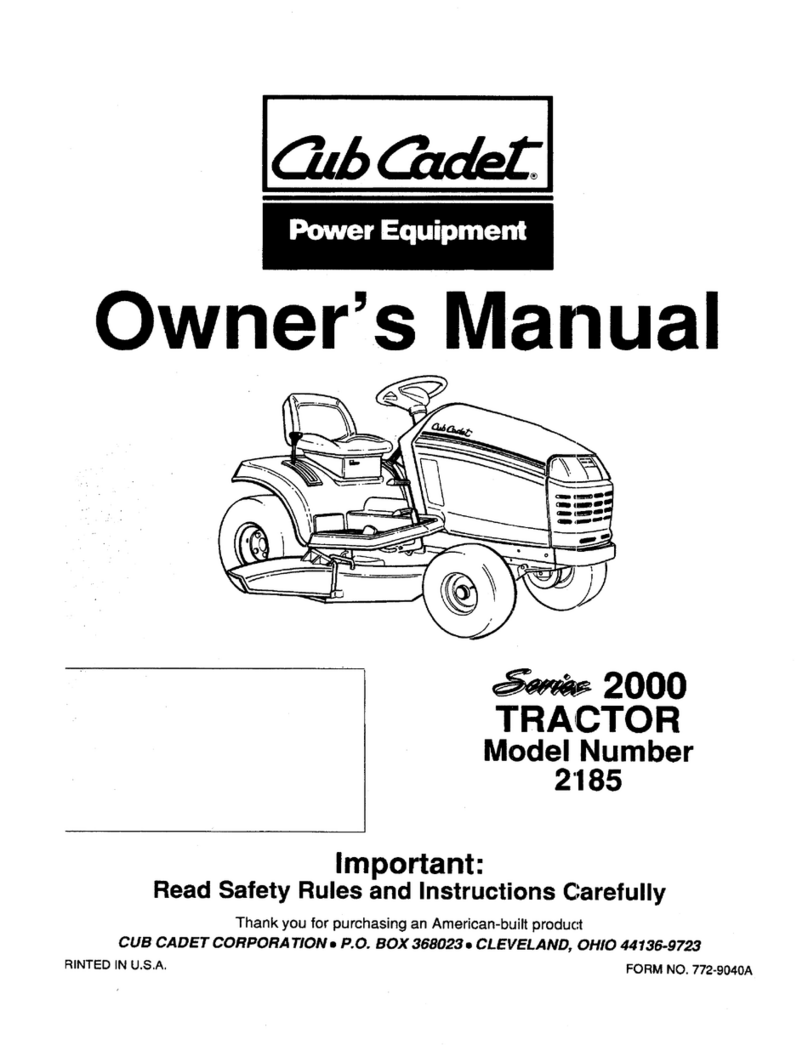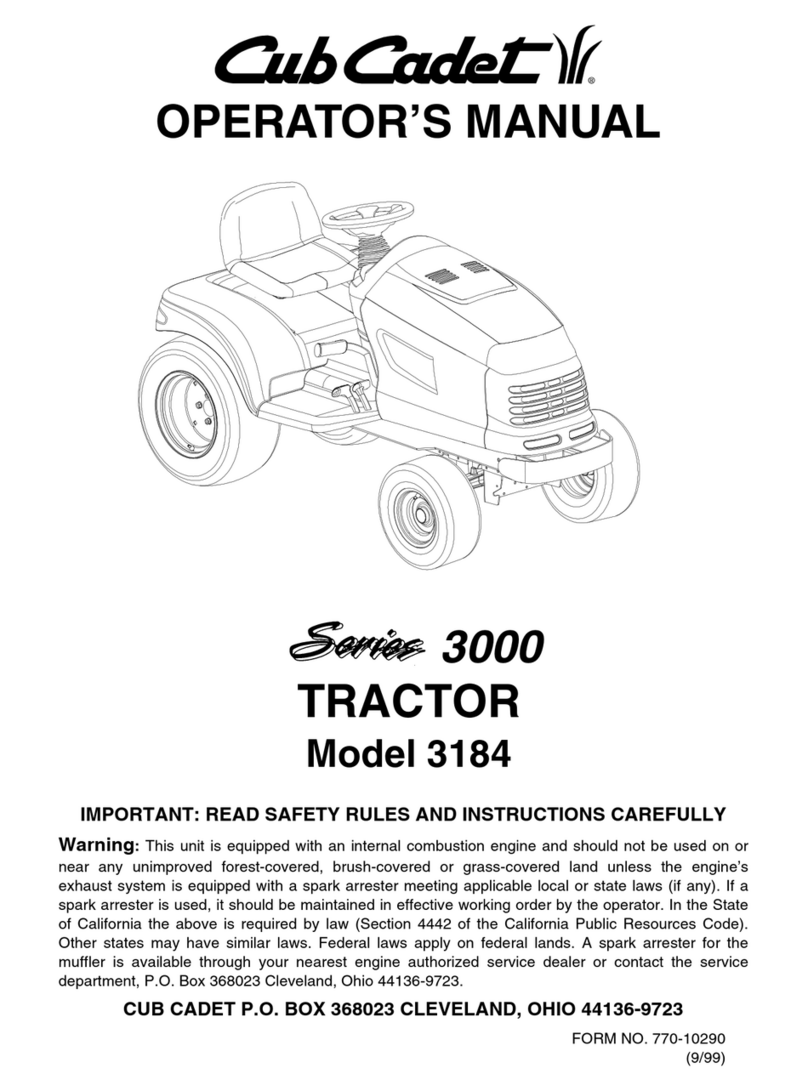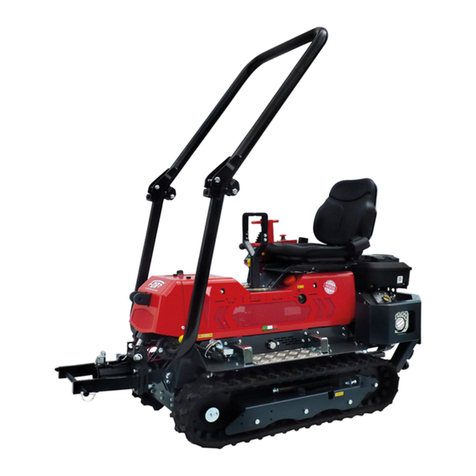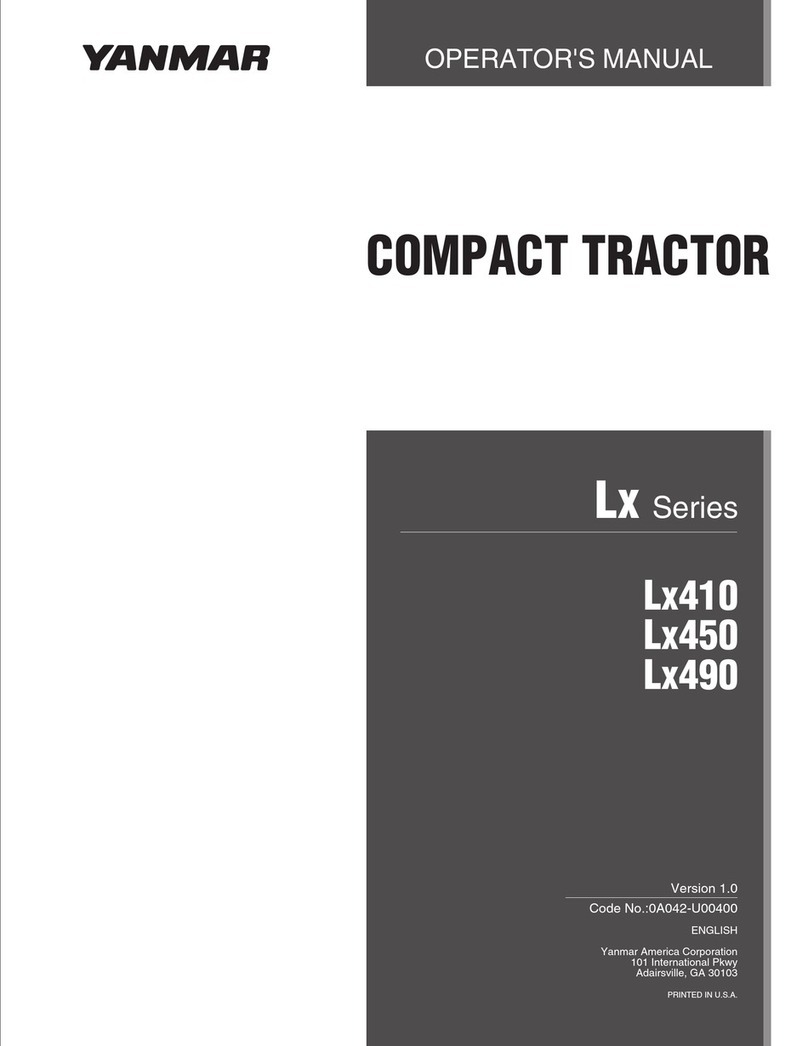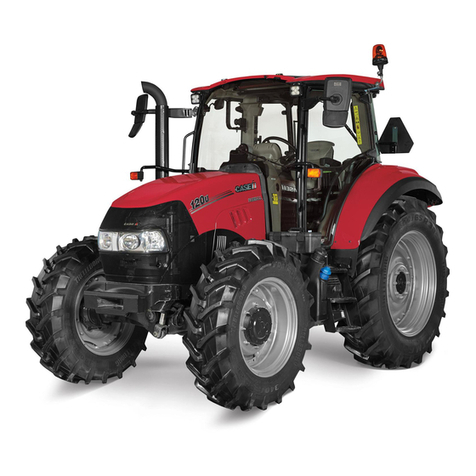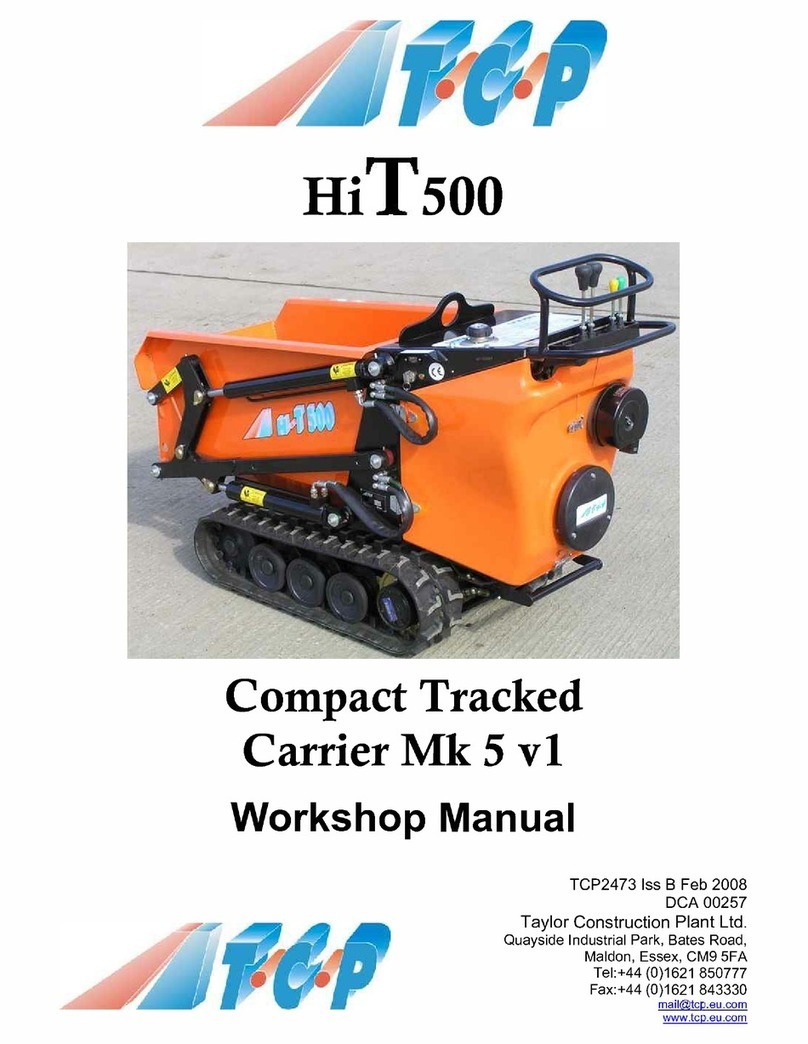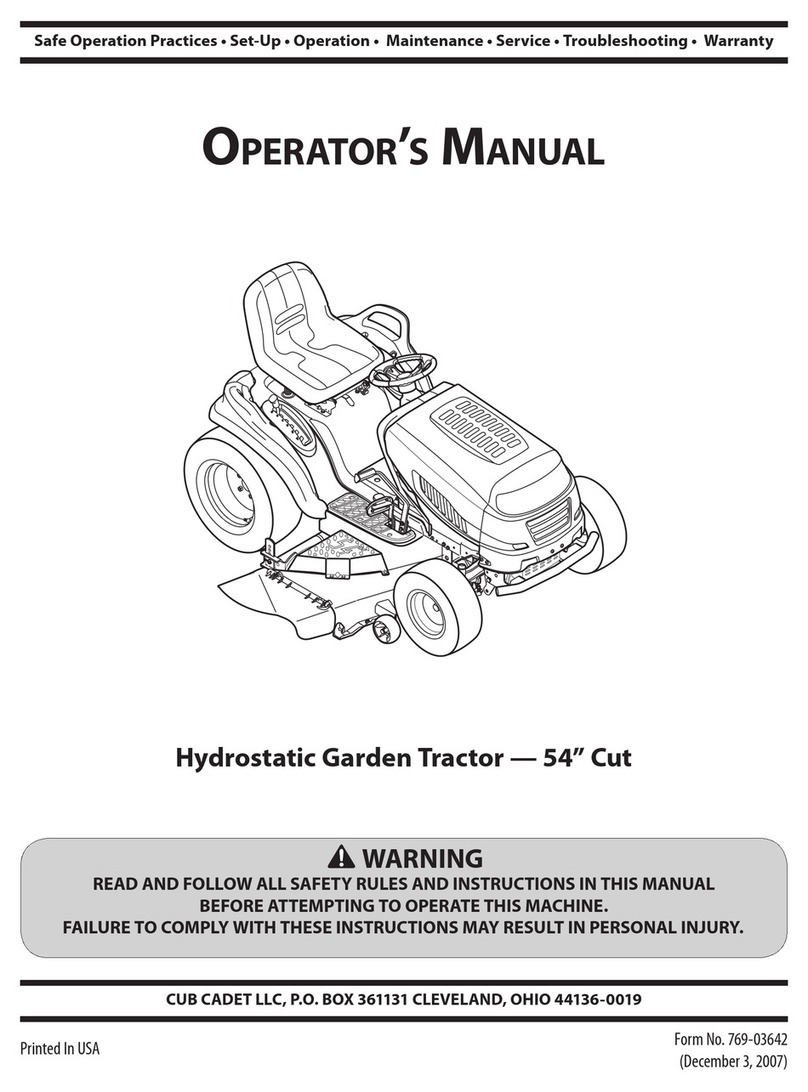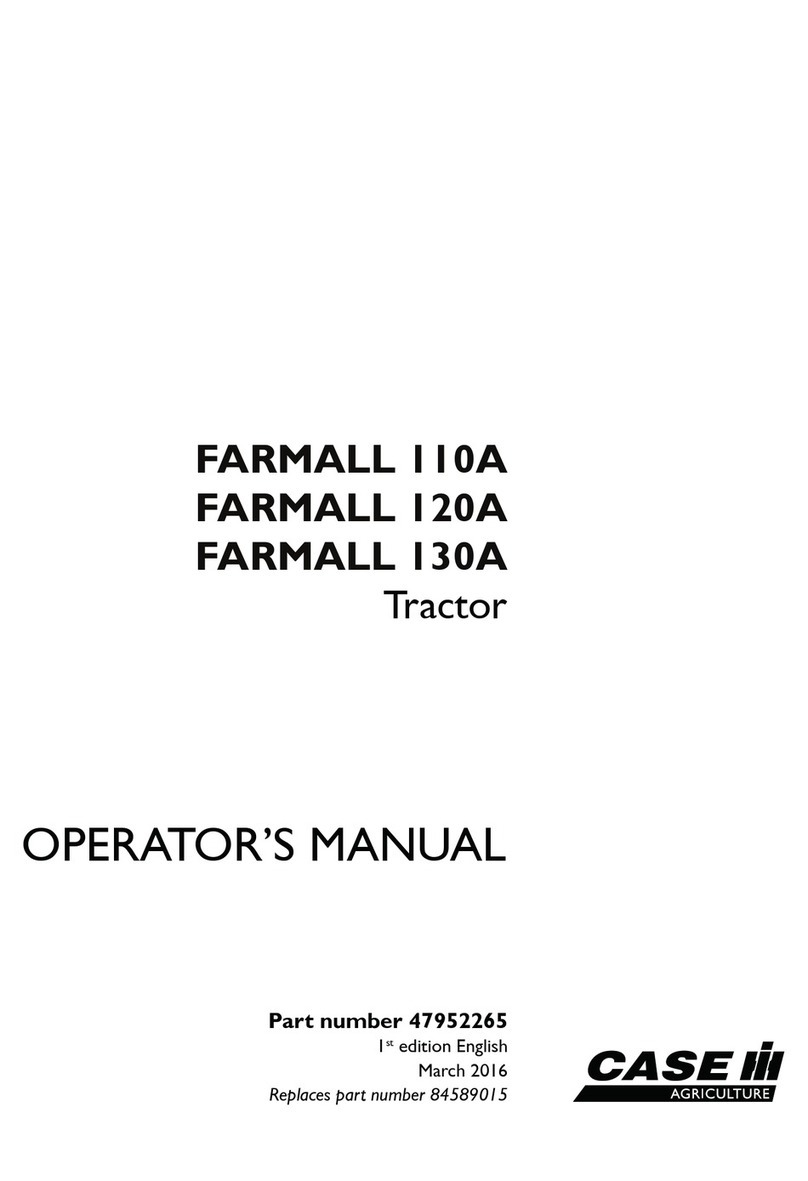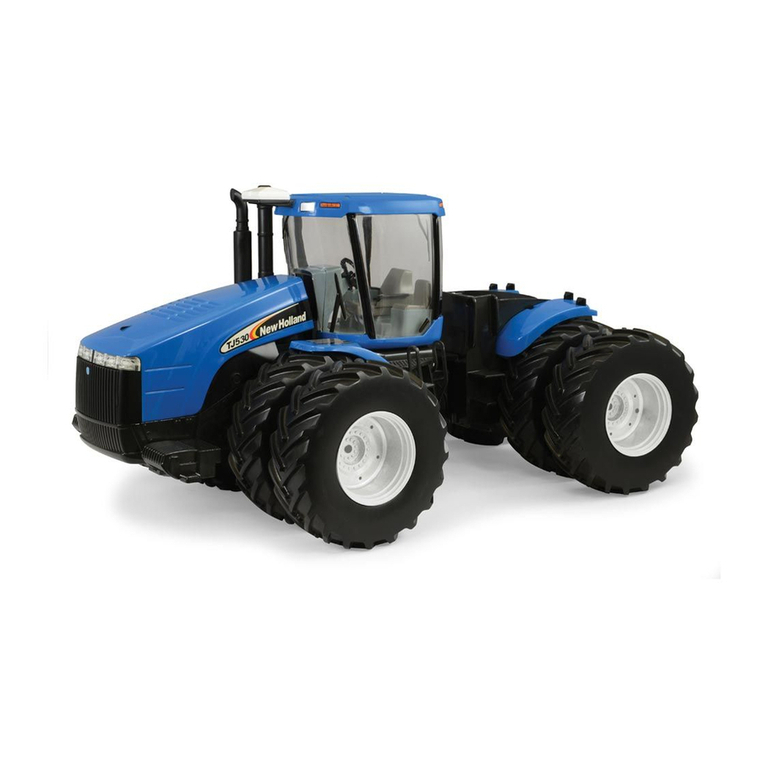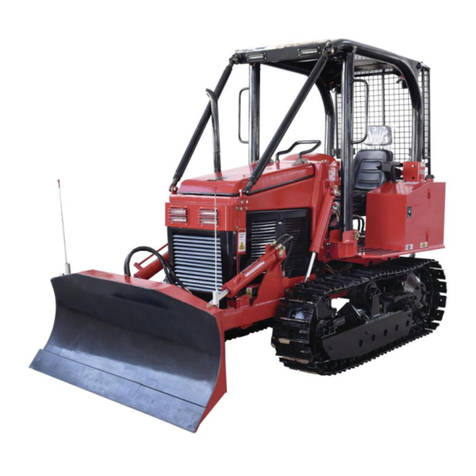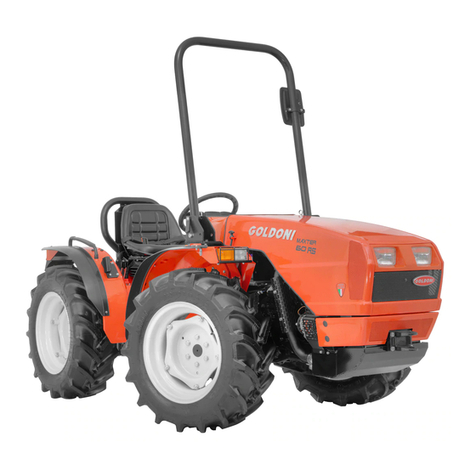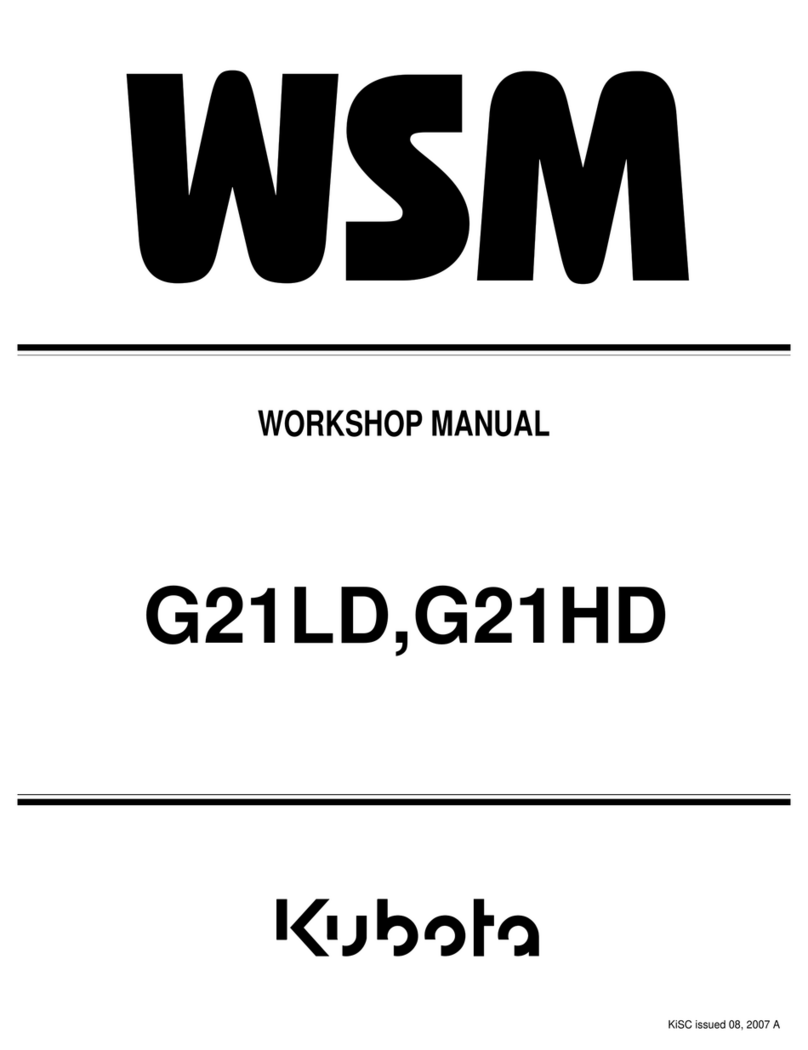Textron Steiner 420 Owner's manual

Owner/Operator's Manual
Form # 09-248C
4 x 4 TRACTOR
Model 420
Starting Serial No. 1001
CAUTION
Avoid injuries. Read and understand Operator’s manual
before operating tractor or equipment.
It contains instructions for safe operation.

Date of Purchase: Month ________________Day____________________Year _______________
Dealer Name _________________________Phone__________________
Serial Number ________________________
Model Number ________________________
ALWAYS GIVE MODEL AND SERIAL NUMBER WHEN ORDERING SERVICE PARTS
• READ AND UNDERSTAND OPERATORS MANUAL
BEFORE OPERATING OR SERVICING.
• OBEY ALL SAFETY INSTRUCTIONS. FAILURE TO DO SO
MAY RESULT IN INJURY TO YOU OR OTHERS.
• BE SURE MACHINE IS IN SAFE OPERATING CONDITION
BEFORE USE.
• INSPECT MACHINE DAILY. REPLACE ALL WORN OR
DAMAGED PARTS.
• KEEP ALL GUARDS AND SHIELDS IN PLACE.
• CHECK OPERATION OF ALL SAFETY INTERLOCK
SWITCHES DAILY.
• DO NOT OVERRIDE INTERLOCK SYSTEM, IT IS FOR YOUR
PROTECTION.
• DO NOT ALLOW MINORS OR THE INEXPERIENCED TO
OPERATE MACHINE.
• KEEP PEOPLE AND PETS A SAFE DISTANCE AWAY FROM
MACHINE USING POWER DRIVEN ATTACHMENTS.
INJURY COULD RESULT FROM FLYING DEBRIS.
CAUTION
STEINER TURF EQUIPMENT, INC.
289 N. Kurzen Rd., P.O. Box 504
Dalton, Ohio 44618
Telephone: (330) 828-0200
FAX: (330) 828-1008

TABLE OF CONTENTS
INTRODUCTION SECTION 1 page
Introduction...............................................................................................2
Specifications ...........................................................................................3
SAFETY SECTION 2
General Safety ........................................................................................4
Operator Safety ........................................................................................4
PRE-START INSTRUCTIONS SECTION 3
Starting Instructions..................................................................................5
Fuels and Oils ..........................................................................................5
OPERATION SECTION 4
Controls ....................................................................................................6
Operating Precautions..............................................................................8
Operating Instructions ..............................................................................8
SERVICE SECTION 5
Service Schedule .....................................................................................16
Oil Change Procedures ............................................................................17
Adjustments..............................................................................................18
Trouble Shooting Chart ............................................................................20
Emergency Moving...................................................................................21
ASSEMBLY INSTRUCTIONS SECTION 7
Assembly Instructions ..............................................................................22
Warranty ...................................................................................................last
page
1
Form #09-248C 4/95

2
INTRODUCTION section 1.1
Description
•The Steiner 4 wheel drive tractor is designed with the user in mind. From the rugged industrial frame to the
operator controls, the tractor is ready for demanding turf and grounds care assignments.
•Power steering and articulated frame, combined with a low center of gravity and high flotation tires, provide
exceptional maneuverability.
•Fully hydrostatic, single lever control lets you choose infinite ground travel speeds to match the task. No
clutching, jerking or braking, just smooth power flow to the 4 full time drive wheels for added traction in tough
areas. 2-speed transaxles allow a choice of “HIGH” or “LOW” range.
•Front mounted attachments offer a wide range of working tools and all of them attach to the “Quick Hitch” that
is a Steiner exclusive. The front hitch is standardized for all models of Steiner power units so your present
attachments are not obsolete.
•You can do many tasks with this one tractor, compared to higher priced single purpose machines, by simply
changing attachments in less than 2 minutes.
•Operator safety and comfort, power, performance and dependability will provide years of enjoyment with your
Steiner tractor.

3
INTRODUCTION section 1.2
SPECIFICATIONS
Dimensions:
Overall Width _____44"
Overall Length _____64"
Overall Height _____46"
Wheelbase ______38"
Inside Turning Radius _ _ 46"
Weight (Onan) _____990lbs.
Weight (Kohler)_____990lbs.
Weight (Kubota) ____1100lbs.
Engine:
Standard _______Onan P220 Performer
20 HP air-cooled
Optional _______Kubota D600B Diesel
liquid-cooled 16.5 HP
Optional _______Kubota WG600B Gas
liquid-cooled 21 HP
Optional _______Kohler Command V-Twin
22 HP air-cooled
Drive Train:
Transmission______Sundstrand Hydrostatic
Series 15 Pump and
2 motors
Transaxles ______Peerless 2500 Series
2-speed
SPEEDS:
Forward (Traction Type Tires) ______0-8.5 MPH
(high range)
0-4.4 MPH (low range)
Reverse (Traction Type Tires) ______0-5.3 MPH
(high range)
0-2.8 MPH (low range)
Steering _______Hydraulic
power steering
Parking Brake _____Disc type
Tires:
Traction Type _____21x11.00-8, Rawhide
Turf Type, optional ___20x10.00-8, Turfmate
Electrical:
Starting ________12volt, Key switch
Battery ________12volt, Group 26
Fuel System:
Tank capacity _____6Gallons
Fuel Pump ______Diaphragm (Onan)
Diaphragm (Kohler)
Electric (Kubota)
Specifications are subject to change without notice.

GENERAL SAFETY
1. Read and understand the owner’s manual, be-
fore attempting to operate this machine.
2. Operate all controls from the operator’s seat. NO
RIDERS.
3. Keep all shields in place and safety switches ad-
justed properly.
4. Do not leave equipment unattended. STOP the
engine and remove the key.
5. Do not allow minors or the inexperienced to op-
erate this machine.
6. Keep people and pets a safe distance away from
machine using power driven attachments. In-
jury could result from flying debris.
OPERATING SAFETY
1. STOP ENGINE to install drive belts or make ad-
justments.
2. WARNING! The tractor may coast when the en-
gine stops. Set Parking Brake.
3. DO NOT TOW! Serious damage to the hydraulic
system will result. See Section 5.6 for emer-
gency moving instructions.
4. DO NOT attempt to work on unit or any attach-
ments with the engine running. STOP ENGINE!
5. Before leaving the tractor seat:
1. Disengage PTO Drive.
2. Set Parking Brake.
3. Stop engine.
4
SAFETY section 2.1
BE ALERT!
ATTENTION:
This symbol identifies potential health and safety
hazards. It marks safety precautions. Your safety
and the safety of others is involved.
SIGNAL WORD DEFINITIONS
Indicates an imminently hazardous situation which,
if not avoided, will result in death or serious injury.
This signal word is limited to the most extreme
cases.
Indicates a potentially hazardous situation which, if
not avoided, could result in death or serious injury.
Indicates a potentially hazardous situation which, if
not avoided, may result in minor or moderate injury
and/or property damage. It may also be used to
alert against unsafe practices.
WARNING
The engine exhaust from this product
contains chemicals known to the State of
California to cause cancer, birth defects
or other reproductive harm.
CALIFORNIA
Proposition 65 Warning
Diesel engine exhaust and some of its
constituents are known to the State of
California to cause cancer, birth defects and
other reproductive harm.

5
PRE-START INSTRUCTIONS section 3.1
BEFORE STARTING:
1. READ SAFETY DECALS
2. Check engine and transaxle oil levels.
3. Visually check tires.
4. Visually check for loose or missing parts or bolts.
5. Fill with clean fuel.
6. Check coolant level. (Kubota)
STARTING INSTRUCTIONS:
1. Safety switch requires Forward - Reverse lever to
be in NEUTRAL and PTO to be OFF for engine to
start.
2. Open throttle approximately one-fourth of its travel.
3. GASOLINE ENGINES: Pull choke until engine
starts.
DIESEL ENGINE: Turn key counter-clockwise to
“preheat”.
Over 32° F.(0° C.) 15 sec.
Below 32° F.(0° C.) 30 sec.
No preheat is required when engine is warm.
4. Turn key to start engine.
5. Warm up engine at medium speed. Push in choke
on gasoline engines as engine warms up.
6. In cold weather, allow the hydraulic oil to warm up a
few minutes at medium engine speed before using
tractor.
NEVER USE ETHER AS A STARTING AID, OR
SEVERE DAMAGE TO ENGINE MAY OCCUR.
NEVER FILL FUEL TANK WITH ENGINE
RUNNING!
SPECIFICATIONS FOR FUELS AND OILS
ENGINE OIL
Fill the crankcase with oil that meets API service
designation SF, SF/CC, or SF/CD. Do not mix brands
or grades of oil. Recommended weights for expected
temperatures are:
GASOLINE ENGINES:
Above 32° F.(0° C.)..........SAE 30
Below 32° F.(0° C.)..SAE 10W or 10W-30
DIESEL ENGINES:
Above 77° F.(25° C.) SAE 30
Above 32° F.- 77° F. (0° C.-25° C.).SAE 20 or
10W-30
Below 32° F.(0° C.)..SAE 10W or 10W-30
FUEL
GASOLINE: Use clean, fresh, regular or unleaded
fuel. Use of unleaded fuel results in less
maintenance.
DIESEL: Use clean, fresh No. #2 diesel fuel. In
extreme cold temperatures No. #1 diesel fuel may be
used. Do not use kerosene or damage to engine may
result. Refer to engine manual for fuel bleeding
instructions.
TRANSAXLE HYDRAULIC OIL
Fill transaxle to the safe range with approved
hydraulic oil. Use only Steiner Trans-Hydraulic Oil or
Texas Refinery Corp. 6440 Universal Torque Fluid.
Do not use automatic transmission fluid, motor oil, or
any other type of hydraulic oil.
USE ONLY STEINER TRANS-HYDRAULIC OIL OR
TEXAS REFINERY CORP. 6440 UNIVERSAL
TORQUE FLUID. THE USE OF ANY OTHER OIL
MAY VOID WARRANTY AND IS NOT
RECOMMENDED.
BE ALERT! STOP RUNNING THE UNIT AT THE
FIRST SIGN OF ANY ABNORMAL HYDRAULIC
FUNCTION. SERIOUS DAMAGE TO THE
HYDRAULIC SYSTEM CAN RESULT!
COOLANT
Fill coolant system with a mixture of one part
Permanent Anti-freeze and one part water.

6
OPERATION section 4.1
Photo 2 - Controls
CONTROLS
1. Steering Wheel - Full power steering for easy
handling.
2.ThrottleLever-Throttlecontrolsenginespeed.
3. Oil Light - Warn ing light for low en gine oil pres-
sure.
4. Ammeter - Ammeter shows charging or dis-
chargingofbattery.
5. Hour Me ter -Recordstotalrunningtime.
6.AuxiliaryHydrauliclever- Auxiliarylevercon-
trols the attachments which are connected to
theauxiliarycouplers.Floatpositionisprovided
forthoseattachmentswhichrequirefloat.
7. HydraulicFrontLift Lever - Lift lever controls
frontmountedimplements.Floatpositionispro-
videdforthoseattachmentswhichrequirefloat.
8. Choke - Chokeforcoldenginestarting.
9.Forward-ReverseLever-Singlelevercontrols
forwardandreverseinfinitelyvariablespeeds.
Kubota engines only: The water temperature
gauge is in the dash and the hour me ter is un-
der the hood.

7
OPERATION section 4.2
Controls Continued
10. Rear Transaxle Range Selector Le ver - See
section4.5for HI -LORangeSelec tion
11. Parking Brake Lever - Set parking brake be-
foredismounting.
12. Key Switch -Startingandignition.
13. Light Switch - Lights.
14.PTOLever- Con trols Power Take Offfrontbelt
driveforattachments.
15. Transaxle Range Selector Lever(s)
Serial No. (1001 - 3172)Front and Rear Transaxle
Range Selector Levers Not illustrated - Shifts
transaxles into “HIGH” (2) or “LOW” (1) range.
Note: Always shift front and rear transaxles to the
same range on units with 2 selector levers.
Serial No. (3173 - 4630) Transaxle Range Selector
Lever Not illustrated - Uses one lever mounted on
the front transaxle to shift both front and rear
transaxles into “HIGH” (2) or “LOW” (1) range by
means of a cable to the rear transaxle. See
(Section 4, HI - LO Range Selection)
Serial No. (4631 - )
Front and rear selector levers have a locking
device. Shifts transaxle into “HIGH” (2) or “LOW”
(1) range. (See Section 4, HI - LO Selection)
Note: Always shift front and rear transaxles to the
same range on units with 2 selector levers.
16. Front Hitch Release Lever - Releases quick
hitch latch for attachments.
Photo 3 - Rear Transaxle Range Selector Lever
and Parking Brake (Serial No. 4631 - )
Photo 4 - Key Switch...Light Switch...PTO Lever
Photo 5 - Front Transaxle Range Selector (Serial
No. 4631 - ) and FrontHitch Release Lever.

8
OPERATION section 4.3
OPERATING PRECAUTIONS
Observe all Safety Decals.
Keep all Shields in place.
Do not allow minors or the inexperienced to
operate machine. NO RIDERS!
Slow down on rough, uneven or steep terrain
and for operation of power driven mounted
attachments.
Do not operate mower with other persons in the
area. Irregularities in ground surface can permit
foreign material to be propelled from beneath
deck to cause serious injury or death.
Before leaving operator’s seat, disengage PTO,
set PARKING BRAKE and STOP ENGINE.
Remove key from ignition if maintenance
procedures are to be performed or tractor is to be
left unattended.
Do not Tow! Serious damage to hydraulic system
will result. See Section 4.6 for emergency moving
instructions
Stop running the unit at the first sign of any
abnormal hydraulic function. Serious damage
to the hydraulic system can result.
Rear weights must be used with attachments
over 120 pounds for stability. See attachment
operator’s manual for weight requirements.
Always remove all rear weights when front
mounted attachments are removed, or when
using attachments less than 120 pounds, to
reduce the danger of unit tipping over
backward while climbing steep slopes or
loading ramps.
BE ALERT
Do not tow!
Serious damage to hydraulic system will result.
OPERATING INSTRUCTIONS
1. Read and understand this manual before
attempting to operate this machine.
2. Check all fluid levels before starting unit.
3. Become familiar with all controls and their
functions.
4. Safety interlock requires the Forward - Reverse
control lever to be in the neutral position to start
engine.
5. Select desired engine speed with the throttle.
6. Vary vehicle speed with the Forward - Reverse
control lever. Do not make sharp turns at high
speeds. Always look before backing.
7. Operate mower and other similar front mounted
equipment with front lift lever in “FLOAT” position.
8. Safety seat switch requires operator to be seated
when PTO is “ON” or engine will stop. Disengage
PTO before attempting to start engine.
9. The hydrostatic transmission provides a braking
action when the Forward - Reverse control lever is
returned to neutral.
10. Set parking brake and stop engine before
dismounting.
11. DO NOT TOW! Serious damage to hydraulic
system will result. See Section 4.6 for emergency
moving instructions.
12. Be alert for loose bolts and nuts. It is the operator’s
responsibility to keep bolts tight.
13. Tire pressures are very important! Check tire
pressures according to Service Schedule.
(Section 5.1)
14. See the following pages for more information on
specific operator controls and adjustments.

9
OPERATION section 4.4
OPERATING ON SLOPES
USE EXTRA CARE WHEN WORKING ON
SLOPES. The operator must be experienced with
the Steiner tractor and it’s unique operational
responses. Be alert to dips and rises which change
the general slope. Watch for holes, rocks, and roots
in the terrain and other hidden hazards. Keep away
from drop offs. Avoid ground conditions which will
cause the machine to slide. Maintain engine RPM
and control ground speed with the Forward -
Reverse control lever.
The following recommendations for slopes are only a
guide, based on normal turf conditions. If the
operator is uncomfortable or unsure of the machines
stability, he should cease operation on the slope
immediately.
°30 Degrees max. down slope in forward.
°25 Degrees max. across slope.
°30 Degrees max. up slope in forward.
°25 Degrees max. backing up slope in reverse.
°30 Degrees max. backing down slope in
reverse.
On uneven, loose or wet ground, the angles should
be reduced. Only smooth maneuvers (not erratic)
should be made to help maintain stability. Avoid high
speeds and sharp turns on slopes. Do not start or
stop suddenly when going uphill or downhill.
MAXIMUM ENGINE INCLINATION
RECOMMENDATIONS
When using an engine in an inclined position
continuously, the following points must be
remembered:
1. The effective volume of the fuel tank becomes
less, so air suction must be prevented.
2. The effective volume of the engine oil sump is
reduced, increasing the possibility of improper
engine lubrication.
THE ULTIMATE
RESPONSIBILITY FOR SAFE
OPERATION ON SLOPES
RESTS WITH THE OPERATOR.
Position Less than 10 min-
utescontinuousop-
eration
Continuous
operation
Front up 30° 25°
Front down 30° 25°
Left or right
side down 30° 25°

10
OPERATION section 4.5
HIGH - LOW RANGE SELECTION
(Se rial No. 1001 - 3172)
(NotIllustrated)
These units used two selector levers, located on the
front and rear transaxle.
Note: Always shift the front and rear teransaxles to
the same range on units with two selector levers.
(Se rial No. 3173 - 4630)
These units use one selector lever to shift both
transaxles. The selector lever is mounted on the front
transaxle and connects to the rear transaxle with a
cable.
Select ranges only when the unit is stationary and on
a level surface.
Do not attempt to select ranges on slopes or
when the unit is traveling. Select ranges only on
level surfaces. The single selector lever causes
both transaxles to be momentarily in neutral
between ranges. Tractor will coast if shifted on a
slope.
Shift carefully, to be sure the selector lever is
completely engaged. A slight forward or reverse
movement may be necessary for complete gear
engagement.
(Se rial No. 4631 - )
Beginning with Serial No. 4631 a locking device has
been installed on the gear range selector levers. The
units are shipped with the transaxle gear range
selector in HIGH (2) range. This range selection is
recommended for most of the operating tasks. If
slower speeds and more responsive F-R control is
needed, use LOW (1) range selection. See
instructions for transaxle range selection in section
4.6
Photo 12 - Front Transaxle Selector Lever
(Serial No. 4631 - )
Photo 13 - Rear Transaxle Selector Lever
(Serial No. 4631 - )
Photo 6 - Transaxle Selector Lever
(Serial No. 3173 - 4630)

11
INSTRUCTIONS FOR TRANSAXLE
RANGE SELECTION
(Se rial No. 4631 - )
1. Stop the unit on a level surface and set PARKING
BRAKE.
2. Stop the engine and dismount.
3. Remove the 1/4 x 3/4 flange bolt from the lever lock
strap and swing it away from the lever, revealing a
slot. (See Shift Position drawing.)
4. Shift the range selector lever, observing the 2 - N - 1
decal for range selection. A slight rocking motion of
the unit may be needed to fully engage the
selector.
5. With the selection completed, replace the lock strap
andtightenthe1/4x3/4 flange bolt to 12 -15ft.lbs.
torque. (See Locked Position drawing.)
6. Repeat step 3, 4, and 5 for the other transaxle. Be
sure to shift both transaxles into the same range or
serious mechanical damage will result!
DO NOT OPERATE UNIT WITHOUT THE LEVER
LOCK STRAPS IN THE LOCKED POSITION!
OPERATION section 4.6
EMERGENCY TOWING INSTRUCTIONS
FOR A STALLED UNIT
Both transaxles must be in neutral before moving a
stalled unit. Neutral position is between HIGH (2)
and LOW (1) range position. Release the locking
straps on both transaxles to shift into “Neutral”.
Failure to shift transaxles into “Neutral” will cause
serious damage to the hydrostatic system.
Remember to lock the lever lock strap after towing.
SHIFT BOTH TRANSAXLES INTO
THE SAME RANGE OR SERIOUS
MECHANICAL DAMAGE WILL
RESULT!
TIRE BALLAST
Liquid, foam, rubber or powder ballast in tires
causes excess loads on the drive train and WILL
VOID WARRANTY ON THE DRIVE TRAIN
COMPONENTS of the power unit. Modified or
makeshift weights are not acceptable.

12
AUXILIARY HYDRAULICS
The auxiliary valve and quick couplers are standard
equipment. Keep dust covers in place when couplers
are not in use. Float position is provided for those
attachments which require float.
FRONT LIFT
The front lift control valve is equipped with a detent
float position. Always use “FLOAT” position when
mowing, sweeping, etc.
The QUICK HITCH allows fast interchange of
attachments. Push down on hitch control handle to
open latches. Install the attachment. Pull up control
handle to close and lock latches. See PTO BELT
DRIVE for power driven attachments and drive belt
installation.
PTO BELT DRIVE
A belt drive is provided for power transfer to
attachments.
The attachment drive belt is installed around the left
hitch arm before the attachment is connected to the
front lift Quick Hitch. To install the drive belt: Lift up
on the belt release catch located on the right front
frame and push toward the center of the tractor.
Install the implement drive belt on the pulleys and
pull the roll pin T-handle to re-engage the release
catch. (See Photo 7)
Each time a PTO belt driven attachment is installed,
it is necessary to check the drive belt tension. See
PTO BELT ADJUSTMENT on the next page (Section
4.6) for adjustment instructions.
Photo 14 - Auxiliary Hydraulic Couplers
Photo 7 - PTO Drive and Front Lift
(Serial No. 1001 - 2999)
OPERATION section 4.7

13
OPERATION section 4.8
PTO BELT ADJUSTMENT
It is necessary to check the PTO belt adjustment
•A. Each time a new attachment is installed.
•B. If the PTO drive belt slips or does not release properly.
1. Attach the new implement using the correct
attachment drive belt. See the Attachment
Operator’s Manual for the correct belt. Note: A
drive belt chart is included in Section 4.7
2. Stop the engine, engage the PTO lever and check
the distance as shown in Figure 1. The correct
distance between the PTO drive belt is 2 inches. If
the distance is less than 2 inches the drive belt
may slip. If the distance is greater than 2 inches
the drive belt may not release properly when the
attachment is raised to the highest position.
Figure 1 - PTO Belt Adjustment (Serial No. 1001 - 2999)
3. Disengage the PTO and adjust the double idler in
the idler arm mounting slot to obtain the correct
measurement stated in step 2.Note: Normally the
idler bolt is near the center of the slot. If it is at
either end of the slot and correct measurement is
notpossible,checkforan improper size drivebelt.
4. Start the unit and raise the attachment to full
height. The attachment should not run with PTO
disengaged. If it does, the drive belt adjustment is
too tight. Repeat Steps 1 through 4.
STOP ENGINE! DO NOT ATTEMPT TO INSTALL BELTS
OR MAKE BELT ADJUSTMENTS WITH THE ENGINE RUNNING.

14
OPERATION section 4.9
FRONT LIFT and PTO DRIVE
Follow these steps for installation of
front mounted attachments:
1. Place the correct size attachment drive belt around
the left hitch arm of the attachment before
mounting to the quick hitch front lift. See the belt
size chart for belt sizes.
2. Mount the attachment to the quick hitch front lift.
Push down on the front hitch release lever to open
latches. Pull up to lock latches. (See Photo 8)
3. On attachments with auxiliary hydraulics, connect
the hoses to the quick couplers.
4. For power driven attachments, follow additional
steps 5 through 8.
5. Stop engine, lift up on the belt release catch located
on the right front frame and push toward the center
of the tractor. (See Photo 8)
6. Install the attachment drive belt on the PTO drive
pulley of the tractor.
Photo 8 - PTO Drive and Front Lift (Serial No. 3000 - )
7. Each time a PTO belt driven attachment is installed,
it is necessary to check the drive belt tension. See
PTO BELT ADJUSTMENT on the next page
(Section 4.8) for adjustment instructions.
8. Operate mower and other similar front mounted
equipment with front lift lever in “FLOAT” position.
Belt Size Chart for Model 420
Model Description Part No.*
Engine Drive Pulley to Idler 81-B039
All Rotary Mowers 81-A040
CS312 Chipper Shredder 81-B041
LD300 Loader 81-A026
PB100 Power Blower 81-A040
RS350 Rotary Sweeper 81-A040
SB348 Snowblower 81-A053
SC101 Stump Cutter 81-A044
TL348 Tiller 81-A040
* See attachment parts manual for correct belt Part
Numbers. Use only Steiner approved belts.

15
OPERATION section 4.10
Figure 2 - PTO Belt Adjustment (Serial No. 3000 - )
PTO BELT ADJUSTMENT
It is necessary to check the PTO belt adjustment...
•A. Each time a new attachment is installed.
•B. If the PTO drive belt slips or does not release properly.
1. Attach the new implement using the correct
attachment drive belt. See the Attachment
Operator’s Manual for the correct belt. Note: A
drive belt chart is included in Section 4.7
2. Stop the engine, engage the PTO lever and check
the distance as shown in Drawing 1. The correct
distance between the PTO drive belt is 2 inches. If
the distance is less than 2 inches the drive belt
may slip. If the distance is greater than 2 inches
the drive belt may not release properly when the
attachment is raised to the highest position.
3. Disengage the PTO and adjust the idler slider
assembly by turning the belt release catch handle
clockwise to tighten belt and counter clockwise to
loosen belt. Adjust to obtain the correct
measurement stated in step 2.
Note: If correct measurement is not possible,
check for an improper size drive belt.
4. Start the unit and raise the attachment to full
height. The attachment should not run with PTO
disengaged. If it does, the drive belt adjustment is
too tight. Repeat Steps 1 through 4.
STOP ENGINE! DO NOT ATTEMPT TO INSTALL BELTS OR
MAKE BELT ADJUSTMENTS WITH THE ENGINE RUNNING.

16
SERVICE section 5.1
SERVICE SCHEDULE
500 HOUR, ANNUAL
100 HOUR
50 HOUR
DAILY, PRESTART
SERVICE SCHEDULE
500 HOUR, ANNUAL
100 HOUR
50 HOUR
DAILY, PRESTART

17
SERVICE section 5.2
ENGINE OIL CHANGE PROCEDURE
Onan:
25 hours initial;
50 hours thereafter.
Kohler:
5 hours initial;
100 hours thereafter.
Kubota:
35 hours initial;
100 hours thereafter.
1. Run engine until engine is warm for complete
draining.
2. Remove oil drain plug(Onan & Kohler).
Open drain cock(Kubota).
3. Remove oil filter and wipe filter base clean.
4. Lube filter gasket with oil and install new filter.
Tighten 1/2 turn after seal contacts base. Do not
over tighten.
5. Re-install drain plug(Onan & Kohler).
Close drain cock(Kubota).
6. Onan:
Add 1.8 U.S. Quarts (1.7 liter) engine oil.
Kohler:
Add 2.1 U.S. Quarts (2 liter) engine oil
Kubota:
Add 3 U.S. Quarts (2.9 liter) for Kubota engines.
Refer to engine manual for oil specifications.
7. Run engine and check filter and drain plug or cock
for leaks.
8. Stop engine and refill to proper oil level.
THE USE OF ANY AIR FILTER OR OIL FILTER
OTHER THAN THOSE SPECIFIED BY THE ENGINE
MANUFACTURER WILL VOID WARRANTY AND IS
NOT RECOMMENDED.
TRANSAXLE OIL CHANGE
PROCEDURE
Change hydraulic filter after first 50 hours. Change
hydraulic oil and filter at 100 hours initially, and
annually or at 500 hour intervals thereafter,
whichever occurs first. Change oil and filter at any
time contamination is suspected. Approximately 3
gallons of approved hydraulic oil are needed to
change oil.
1. It is best to drain transaxles after the tractor has
been thoroughly warm to assure maximum drain.
2. Remove fill caps and drain plugs from transaxles.
3. Remove hydraulic filter and wipe filter base clean.
4. Lube filter gasket with oil and install new Steiner
filter. Tighten 3/4 turn after gasket contacts filter
base. Do not over tighten.
5. Re-install drain plugs in transaxles.
6. (Serial No. 1001 - 2999)
Add 5 quarts (4.6 liters) approved hydraulic oil to
the rear transaxle. Fill the front transaxle to the full
mark on the dipstick.
(Serial No. 3000 - )
Add 5 quarts (4.6 liters) approved hydraulic oil to
the front transaxle. Fill rear transaxle to the oil level
at the rear cap. Fill to the top of the neck. Use only
Steiner Trans-Hydraulic Oil or Texas Refinery
Corp. 6440 Universal Torque Fluid.
7. Run engine, and turn steering wheel extreme right
to extreme left several times to purge all air from
the circuit.
8. Drive the unit back and forth about 50 feet to purge
air from the drive circuit.
9. (Serial No. 1001 - 2999) Re-check oil level on the
dipstick to be sure it is in the safe operating range.
(Serial No. 3000 - ) Re-check rear transaxle oil
level to be sure it is to the top of the neck at the oil
level cap. Safe operating level is at the full mark on
the dipstick or to the top of the neck. (See also
Section 5.3 for transaxle oil levels.)
THE USE OF ANY OIL OTHER THAN STEINER
TRANS-HYDRAULIC OIL OR TRC 6440
UNIVERSAL TORQUE FLUID WILL VOID
WARRANTY AND IS NOT RECOMMENDED.
THE USE OF ANY HYDRAULIC OIL FILTER
OTHER THAN A STEINER HYDRAULIC OIL
FILTER WILL VOID WARRANTY AND IS NOT
RECOMMENDED.

18
SERVICE section 5.3
HYDROSTATIC TRANSMISSION
When servicing any part of the hydrostatic
system, observe clean shop practices. A small
amount of contamination in the high pressure
circuit will cause damage to the system. Improper
hoses can cause injury. See your Steiner dealer
for quality service parts and service of the high
pressure hydrostatic system.
TRANSAXLE OIL LEVELS
(Serial No. 1001 - 2999 only)
After a period of time the level on the front transaxle
dipstick may show to be low even though there are
no apparent oil leaks. This condition could be
caused by a transfer of oil from the front transaxle to
the non-vented rear transaxle replacing the air cavity
in the rear transaxle.
Before refilling front transaxle to the top mark on the
dipstick, remove the “top plug” on the rear transaxle
and allow air to enter to equalize the oil levels in the
transaxles. After oil level is stabilized, replace the
plug and refill the front transaxle as needed.
Equalize oil levels any time an excessive amount of
oil, more than a quart (liter), needs to be added to
the front transaxle.
TRANSAXLE OIL LEVELS
(Serial No. 3000 - only)
After a period of time the level on the rear transaxle
may be low even though there are no apparent oil
leaks. This condition could be caused by a transfer
of oil from the rear transaxle to the vented front
transaxle. Add oil only to the rear transaxle to
bring it up to the top of the filler neck. It is normal
for the front transaxle to appear over full if the filler
cap is removed. If oil appears to overflow from the
vent hose of the hydraulic system expansion tank,
contact your Steiner dealer for hydrostatic repairs.
Forward - Reverse Lever Tension
Adjustment
Tension is adjusted by tightening the spring-loaded
friction washers on the Forward - Reverse lever.
Tighten the friction washers to hold the lever in the
desired position under normal loads. When the
hydrostatic system is subjected to heavy loads, the
Forward-Reverse lever has a tendency to return to
the neutral position. Additional holding pressure from
your hand may be needed to keep the lever in the
desired position.
Neutral Linkage Adjustment:
Absolute neutral is when the tractor will not creep
with the engine running and the Forward - Reverse
lever in neutral. If the unit creeps it is necessary to
adjust the control linkage. Adjust the linkage by
removing the bolt at one end of the connecting link
and rotate the rod end one-half turn at a time until
the desired setting is reached. Shorten the rod if the
unit creeps forward or lengthen the rod if the unit
creeps backward. Tighten locking nuts when neutral
setting is correct. (see Photo 10)
Rear Transaxle Dipstick
(Serial No. 3000 - only)
Table of contents
Other Textron Tractor manuals

Textron
Textron Steiner 425 Owner's manual
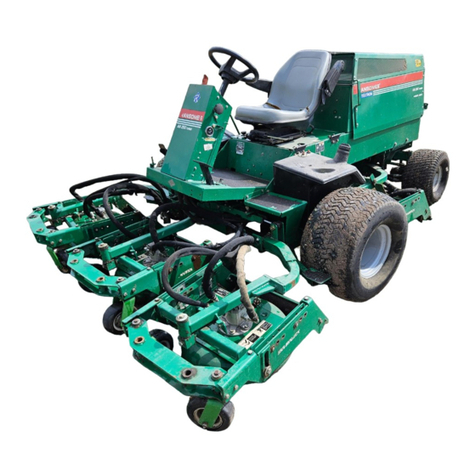
Textron
Textron RANSOMES VN Series Guide
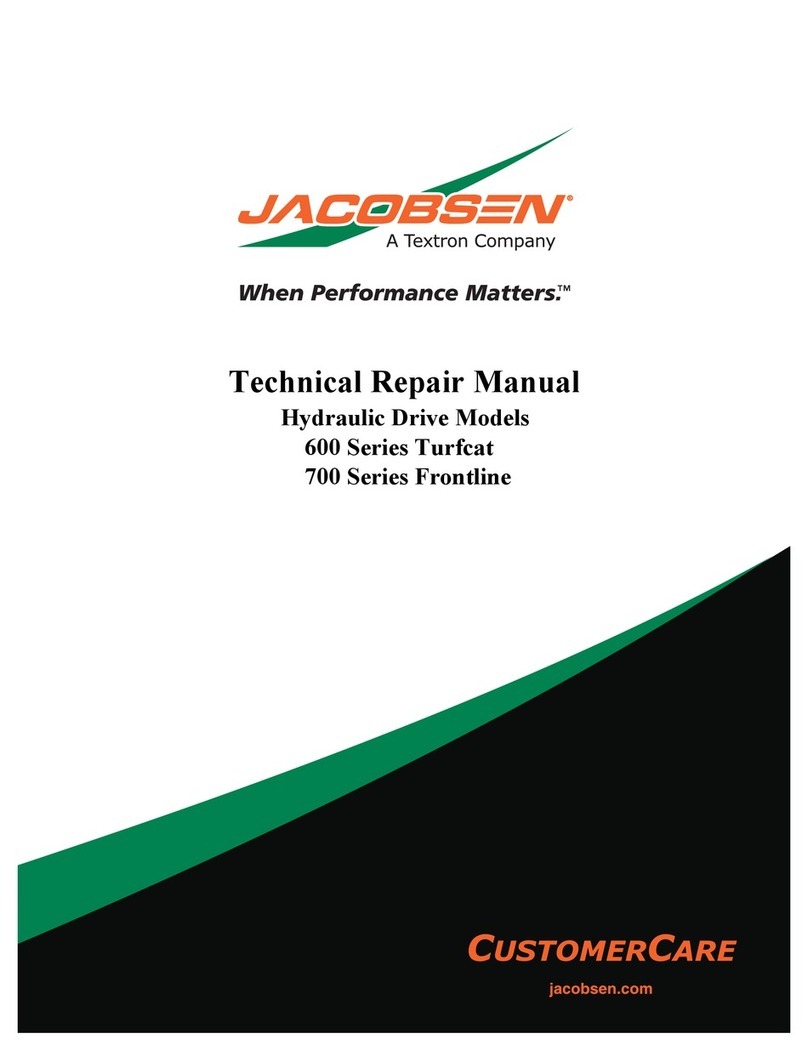
Textron
Textron Jacobsen Turfcat 600 Series Operating instructions

Textron
Textron Steiner 430 MAX Owner's manual

Textron
Textron Ransomes Jacobsen HR3806 Series Guide
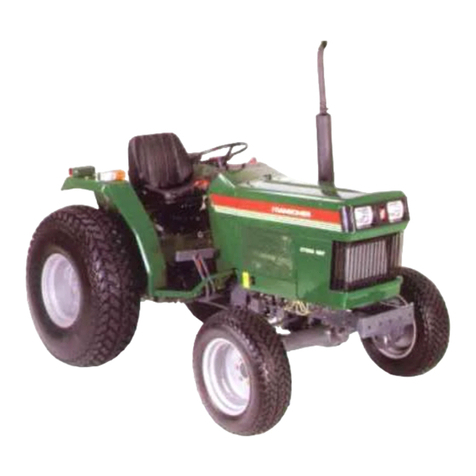
Textron
Textron Ransomes CT435 Specifications
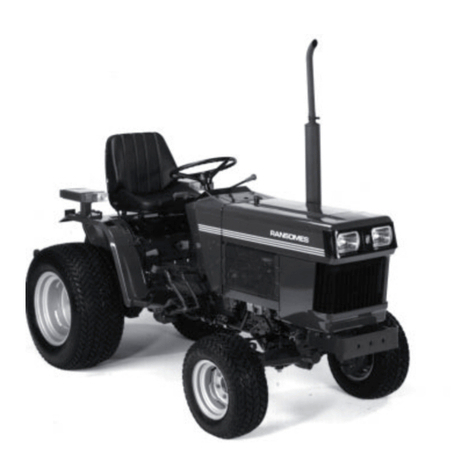
Textron
Textron Ransomes CT445 Specifications
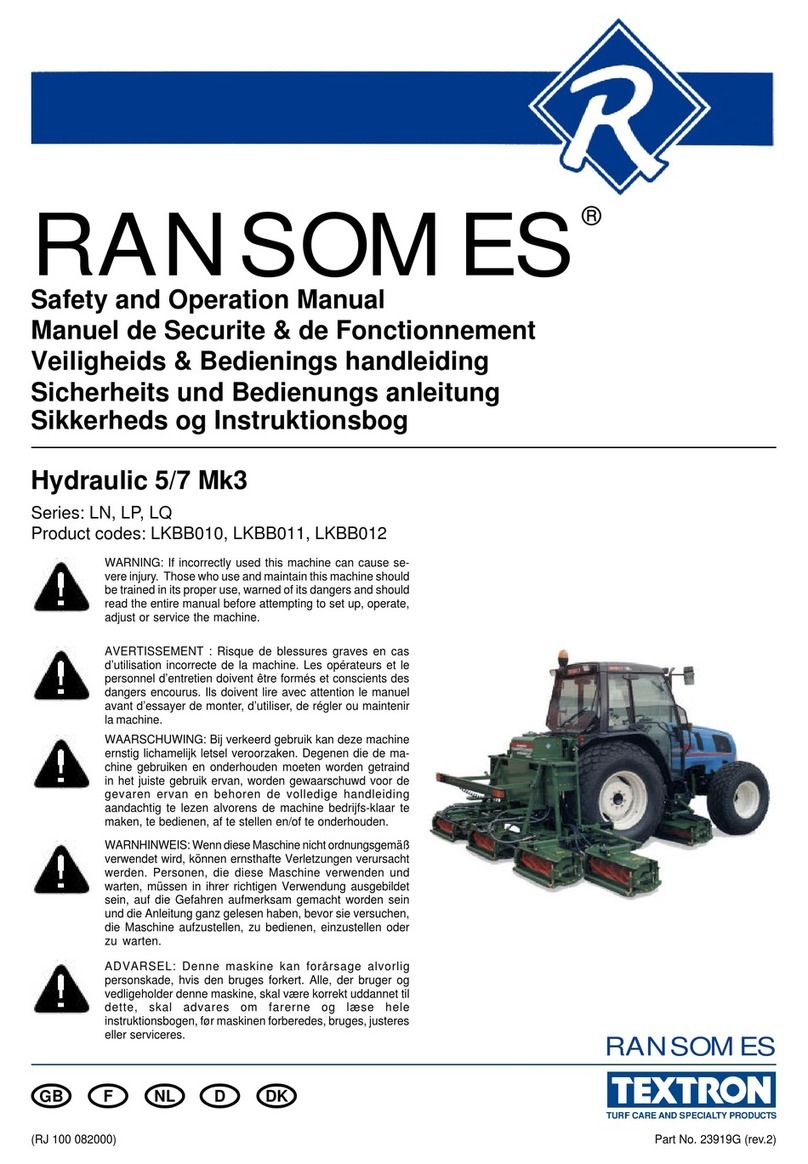
Textron
Textron RANSOMES LN Series Guide
